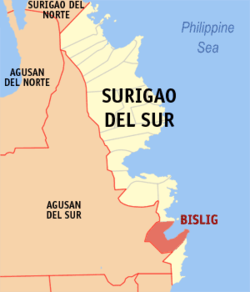Bislig
| Bislig | ||
|---|---|---|
| Component City | ||
| City of Bislig | ||

Skyline of Bislig City on night time showing the nearby Bislig Bay taken at the Ocean View Park in Barangay Cumawas
|
||
|
||
| Nickname(s): The Booming City by the Bay The City of Wonders The Model City for Organic Agriculture in the Philippines by 2020 |
||
| Motto: " Sulig Bislig! " | ||
 Map of Surigao del Sur with Bislig City highlighted |
||
| Location within the Philippines | ||
| Coordinates: 08°11′N 126°21′E / 8.183°N 126.350°ECoordinates: 08°11′N 126°21′E / 8.183°N 126.350°E | ||
| Country | Philippines | |
| Region | Caraga (Region XIII) | |
| Province | Surigao del Sur | |
| District | 2nd district of Surigao del Sur | |
| Incorporated | 1921 (town) | |
| Cityhood | 18 September 2000 | |
| Barangays | 24 | |
| Government | ||
| • Mayor | Librado Navarro | |
| • Vice Mayor | Jonas Cacayan | |
| Area | ||
| • Total | 331.80 km2 (128.11 sq mi) | |
| Elevation | 25 m (82 ft) | |
| Population (2015 census) | ||
| • Total | 94,535 | |
| • Density | 280/km2 (740/sq mi) | |
| Demonym(s) | Bisliganon | |
| Time zone | PST (UTC+8) | |
| ZIP code | 8311 | |
| Dialing code | +63 (0)86 | |
| Income class | 3rd city income class | |
| 166803000 | ||
| Electorate | 56,305 voters as of 2016 | |
| Languages | Visayan (Mindanao Cebuano), Bisliganon Kamayo, Filipino, English and other minority languages | |
| Website | www |
|
Bislig, officially called the City of Bislig and often referred to as Bislig City, is a third income class city in the province of Surigao del Sur, Mindanao, Philippines. According to the 2015 census, it has a population of 94,535 people.
Barangay Mangagoy, the downtown area often dubbed by its residents as "the little city within the city", is the center of trade and industry of Bislig which has a population of 50,000. It is the largest barangay in the city in terms of population and land area. Since Brgy. Poblacion is often referred by the locals simply as 'Bislig', Mangagoy on the other hand is often mistaken as a separate town though it is only just one out of the 24 barangays that comprises the entire City of Bislig.
In 2000, Bislig was converted into a city per Republic Act 8804. It is the easternmost city in the Philippines in terms of geographical location.
The legendary allusions as to how Bislig got its name could be traced back to the era prior to the coming of the Spanish conquistadors. The town got its name from a forest vine of the rattan family that grew in abundance along the banks of its rivers. This vine was noted for its strength and became known for saving a royal couple who crossed the swollen river in one of their hunting expeditions and who almost died as they were carried downstream by the rushing current. The legend has it that these hunters had already lost hope of surviving until they were able to cling to a vine which was about 1/4 inch in diameter called Bislig. As a sign of thanksgiving, the ruler named this place Bislig.
Historically, Bislig derived its name from the word “bizlin”, a kind of gold, “which is worth two pesos a tael. The weight of a tael is one and one-eight ounces” in the 16th century, which the natives used for trade and barter. Prior to the coming of Spaniards, this terminology was understood in Luzon and in Mindanao. In the report of the Administrator of Royal Properties Andres Mirandaola dated 8 September 1573 sent to King Philip of Spain that “much gold found in the island of Mindanao, District of Butuan, Surigao ...” It is believed that this kind of gold found in the rolling hills and mountains of the southernmost portion of Bislig and Agusan Province.
...
Wikipedia


